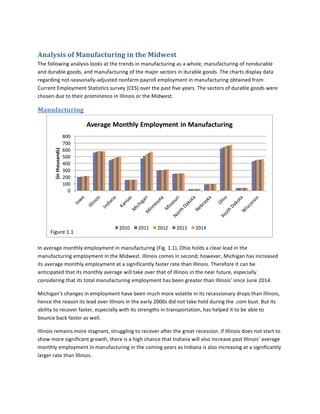More Related Content
Similar to Manufacturing Analysis
Similar to Manufacturing Analysis (20)
Manufacturing Analysis
- 1. Analysis of Manufacturing in the Midwest
The following analysis looks at the trends in manufacturing as a whole, manufacturing of nondurable
and durable goods, and manufacturing of the major sectors in durable goods. The charts display data
regarding not-seasonally-adjusted nonfarm payroll employment in manufacturing obtained from
Current Employment Statistics survey (CES) over the past five years. The sectors of durable goods were
chosen due to their prominence in Illinois or the Midwest.
Manufacturing
In average monthly employment in manufacturing (Fig. 1.1), Ohio holds a clear lead in the
manufacturing employment in the Midwest. Illinois comes in second; however, Michigan has increased
its average monthly employment at a significantly faster rate than Illinois. Therefore it can be
anticipated that its monthly average will take over that of Illinois in the near future, especially
considering that its total manufacturing employment has been greater than Illinois’ since June 2014.
Michigan’s changes in employment have been much more volatile in its recessionary drops than Illinois,
hence the reason its lead over Illinois in the early 2000s did not take hold during the .com bust. But its
ability to recover faster, especially with its strengths in transportation, has helped it to be able to
bounce back faster as well.
Illinois remains more stagnant, struggling to recover after the great recession. If Illinois does not start to
show more significant growth, there is a high chance that Indiana will also increase past Illinois’ average
monthly employment in manufacturing in the coming years as Indiana is also increasing at a significantly
larger rate than Illinois.
0
100
200
300
400
500
600
700
800
(in thousands)
Average Monthly Employment in Manufacturing
2010 2011 2012 2013 2014
Figure 1.1
- 3. In manufacturing of nondurable goods, Illinois employs the greatest number of employees with Ohio not
too far behind. Yet by looking at the percent of manufacturing employees in nondurable goods (Fig. 1.3)
it is evident that Nebraska is the most reliant on nondurable goods manufacturing in the Midwest.
Currently 52.9 percent of its manufacturing employees work with nondurable goods, while only 39.8
percent for Illinois and 31.9 percent for Ohio. The rest of the states in the Midwest are only reliant on
nondurable goods 40 percent or less, making Nebraska the only state to have the majority of its
manufacturing employees working with nondurable goods, though the majority is small.
Durable Goods
Currently, Ohio has the greatest employment in durable goods, but it holds a longstanding competition
with Michigan for this position, as seen in Fig. 1.4. The difference between the two has been decreasing
as they started to recover from the recession in 2009, with the 2014 Ohio employment at 458.2
thousand and Michigan at 437.4 thousand. Illinois and Indiana are in a similar relationship in third and
fourth greatest employment as Ohio and Michigan are for first and second. However, Illinois’ percent
change over the year has been decreasing while Indiana’s has had a slight increase, causing Illinois to
drop to fourth in May 2013. Illinois shows no signs of exceeding Indiana’s employment.
0
50
100
150
200
250
300
350
400
450
500
(in thousands)
Average Monthly Employment in Durable Goods
2010 2011 2012 2013 2014
Figure 1.4
- 11. Michigan puts the most importance on transportation equipment with 40.2 percent of its manufacturing
employees working and showing steady growth. Kansas and Indiana are close behind, but Kansas is
actually in a slight decline (Fig. 1.15). Oddly enough, Kansas has 39.5 percent of its manufacturing
employees in this sector of durable goods, yet that only equates to 39.0 thousand employees, which is
less than Illinois. Illinois is far below most of the Midwest states at only 12.0 percent despite the fact
that transportation is the fourth largest sector for its employees manufacturing durable goods. Illinois is
showing extremely slow growth in comparison to the stronger competitors, but the slow growth is
common among states with less than 30.0 percent of manufacturing employees working with
transportation equipment.
Other Types of Durable Manufacturing
The remaining types of manufacturing either had information for only a few states in the Midwest, or
held little significance to Illinois. A common occurrence with the types of durable manufacturing that
was not discussed was Illinois holding second or third in employment for each type of manufacturing.
However, each type accounted for no more than 40.3 thousand employees and showed no signs of
significant growth.
Conclusion
Even if Illinois held market share in certain manufacturing fields before the great recession, it has since
lost that foothold. The overall trends for each type of manufacturing have been fairly stagnant since the
recession, not indicating any significant changes in the near future. Illinois still has the advantage in the
number employed and the percent employed when it comes to chemicals. And in fabricated metals it is
not too far behind Ohio in number of employees for it to be impossible to gain the upper hand,
especially considering that fabricated metals has the greatest percentage of manufacturing employees
working in durable goods. Other Midwestern states, most notably Ohio, Michigan, and Wisconsin, are
showing greater percent changes than Illinois. In order to help boost manufacturing in Illinois, it would
be wise to look at the approaches of these three states when it comes to manufacturing in order to
ensure that Illinois is not made obsolete in manufacturing in comparison to the rest of the Midwest.
